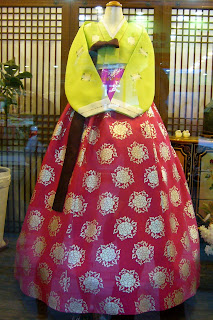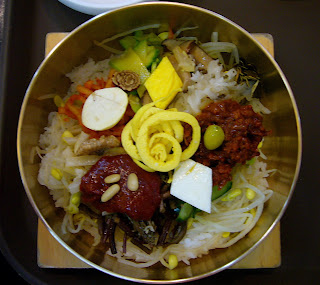Jeju Island 제주도: April 26 - May 3
I wanted to spend my last vacation traveling in Korea. Jeju Island is Korea's most popular domestic tourist destination and I thought that was a good enough reason to go there. Koreans are proud of Jeju and are probably right in thinking that it's the prettiest part of the country. Jeju does get international tourists, but I was the only foreigner on both of my flights and saw only a handful of foreigners on the island. I ran into several large school groups and Korean honeymooners, who were easily identifiable in their identical couple shirts.
Jeju was formed by a volcanic eruption 2 million years ago and has a subtropical climate. Korea's tallest mountain, Hallasan, dominates the geography and can be viewed on a clear day from most anywhere on the island. When I climbed it, however, I could barely see 20 yards in front of me. I kept hoping the fog would burn off by the time I reached the summit so I'd be able to see the crater lake at the top. Unfortunately, the weather did not cooperate and I have no photos from Hallasan to post. I also went to Manjanggul, which is part of the Geomunoreum lava tube system. This UNESCO World Heritage Site is supposed to be the longest lava tube in the world at 8,928 meters, but visitors are only allowed to see 1 kilometer of the tubes. It was too dark for any decent pictures.

traditional Jeju houses and grandfather stone

Cheonjeyeon waterfall

Yongmeori Coast

Korean women selling sea cucumbers and urchins. They'll slice up anything if you want a picnic right there on the rocks. I had ramen at the temple instead...



Hyeopjae beach on the west coast of Jeju, view to Biyangdo island

Sanbangsan Temple


Jeju is famous for its Hallabong, a sweet citrus fruit that's like a cross betweent tangerines and oranges. Hallabong are very expensive on the Korean mainland but are not exactly cheap on Jeju, especially if purchased in the gift boxes. 10 large Hallabong might cost upwards of 30 dollars! I found smaller ones at roadside stands for about a dollar a piece.

Smaller temple and buddha inside a natural cave on the side of Sanbang Mountain

view looking out of the cave

Cheonjiyeon waterfall

On the walk back to the main road from O'Sulloc's Tea Museum. A lot of touristy places on Jeju are not easily accessible by public bus. I caught a ride with a local on the way to the tea museum, which saved me 3 miles of walking. The road was so pleasant though that I happily walked the way back. This walk probably represents the longest that I've been outside in Korea without any other people around. It was glorious!

tea fields- all the walls are made with the black volcanic rocks



Women hang squid (or cuttlefish, I'm not sure which) in the early morning to let it dry. Dried fish and squid are popular snacks in Korea.

Seaweed out to dry


Sunset in Seongsanpo, a small port city on the south east coast of Jeju.

Hongjodangoe-haebin beach on Udo, view to Jeju. Udo island is a 15 minute ferry ride away from Seongsanpo. Udo is a quiet little island with few cars and little activity. I spent a peaceful afternoon riding around the narrow roads on my rented bicycle and relaxing on the beach.

Udo island, view to Jeju island. Jeju is known for its Haenyeo, or women divers. These women, some in their 60s, dive daily for sea cucumbers, urchins and abalone that they can sell to supplement their family income. It's no surprise to me that Jeju women live longer than the men.

traditional houses on Udo

hoedopbap- raw fish with raw vegetables and rice, served with the red pepper paste

buckwheat pa-jeon filled with radishes- delicious!

Seongsan Ilchulbong or Sunrise Peak. I woke up at 4:30 to see the sunrise from the top of this volcanic crater and it was worth it!

























































